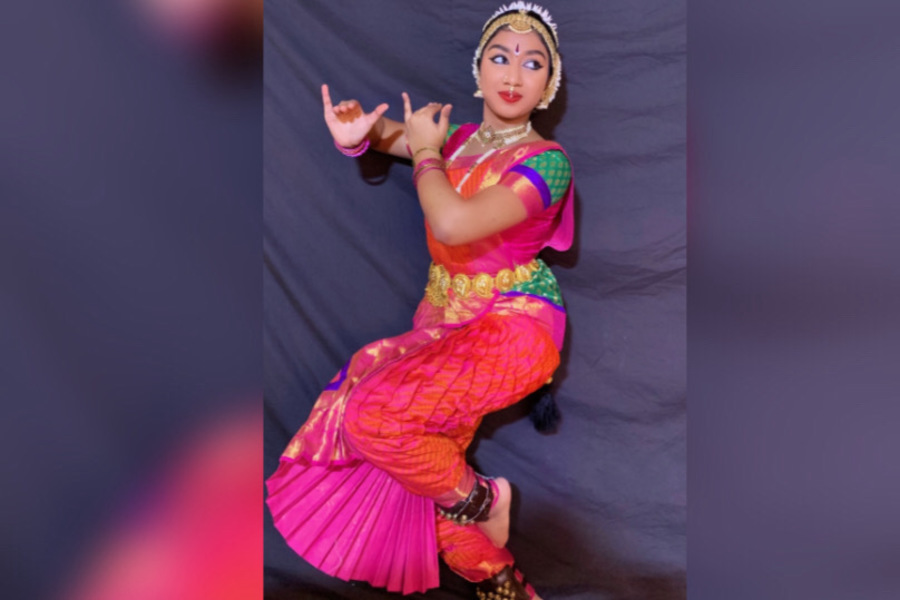caesibbknkxoh5gpypge
{“subsource”:”done_button”,”uid”:”B61DB1A5-7F7E-49AF-AC12-2C6E8E7DC49A_1585108043797″,”source”:”other”,”origin”:”gallery”,”source_sid”:”B61DB1A5-7F7E-49AF-AC12-2C6E8E7DC49A_1585108127604″}
Geethika Bonthala
Name: Geethika Bonthala
Grade: 12
Future college: University of Texas at Austin
Future career: finance
Wingspan: How did you develop an interest in Bharatanatyam, and how long have you been learning it?
Bonthala: “I started learning Bharatanatyam at the age of 5, so I have been practicing the art form for 13 years now. Since I was so young, it was simply an activity my mom enrolled me in to keep me occupied while also being physically active. I don’t think either my mom or I anticipated me pursuing this art for so long, but I think as I grew older and began to understand the depth of dance, I started using it as an outlet for emotions, furthering my interest.”
Wingspan: In ballet, an important event for the dancers is The Nutcracker performance, and many dancers go to various competitions. Does the form of dance you do have any special events or competitions like that?
Bonthala: “There’s a variety of ways and events that Bharatanatyam has. For example, a dancer’s debut solo recital (called an Arangetram) is a very big milestone that is celebrated in this community. Additionally, my studio holds charity productions every few years, in which we all come together to plan logistics of the event, choreograph pieces, and perform based on some theme we choose. There are also various competitions held for Indian classical dance forms within the DFW metroplex that I take part in annually. In these competitions, there are various categories of events, allowing me to perform with my group as well as alone, pushing me to explore my creativity and develop my endurance as a dancer.”
Wingspan: How has this form of dance impacted you both physically and mentally?
Bonthala: “Physically speaking, dancing is quite demanding as you are forced to hold awkward and sometimes painful positions. Furthermore, a traditional recital can be 2-3 hours long, which requires a certain level of stamina. On the other hand, dance also requires you to convey various emotions without being able to verbally communicate. To be able to internalize these emotions and also portray them (despite how physically tired you may be) is quite mentally challenging. All in all, dance has kept me grounded, in shape, and very in touch with my emotions.”
Wingspan: How does this compare to other dance forms in America as well as India?
Bonthala: ”Bharatanatyam is very different from dance forms in America. The movements, attire, and even the stories conveyed are often very different. In regards to other classical forms from India, it is similar to Odissi and Kuchipudi, which are other forms originating from different parts of India. I think one thing that is unique about India and its art forms is that there are various different cultures within Indian culture, allowing for richness and variety of traditions that other demographics may not have.”
Wingspan: In what ways has your opinion on Indian classical dances changed since learning Bharatanatyam?
Bonthala: “Since I started so early on, I don’t think my opinion has changed much. However, I do think that often in society today, classical Indian art forms are sometimes underappreciated and even looked down upon as “backwards” and “primitive.” My investment in this art form has allowed me to have an appreciation and connection to my culture that I might’ve not had otherwise.”
Wingspan: What advice would you give to people who want to learn Bharatanatyam?
Bonthala: “I think the biggest thing I would say is to give it a chance. What I mean by this is that sometimes it is hard to connect to something that seems so far off from the way you live, but once you do create that connection and develop an appreciation for the art form, you will really learn to enjoy it despite how physically and mentally demanding it is.”
Wingspan: How do you balance dance and academics?
Bonthala: “One thing that helps me is trying to develop a healthy routine. For example, this year I am training for my Arangetram, so I practice dance in the morning before going to school. This helps me balance dance and academics as I set aside time for dance, and once that time is over, I am free to study, go about with my other commitments, etc. I would say that having to be timely in my practice has forced me to develop a discipline in my life that I otherwise wouldn’t have.”
Wingspan: Is there anything you wish you had known before learning Bharatanatyam?
Bonthala: “It’s harder than it looks!”
Wingspan: What is one struggle you have had or still have when it comes to this dance?
Bonthala:” I think my stamina and endurance is something I struggle to build and maintain. For example, I was very in shape before I had to take a break due to injury. When I came back, the hardest thing was building my stamina back up to where it was before.”
